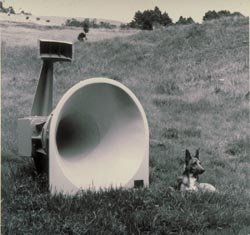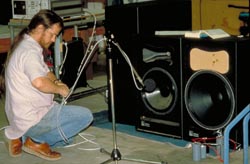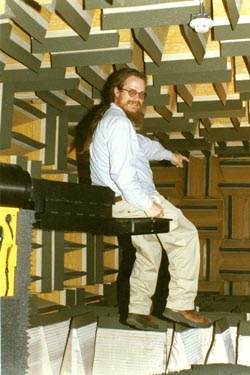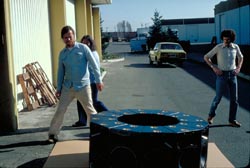THE WAY THEY SEE IT: The Scientific Method

SCN: Where were you when you first thought that loudspeakers could sound better? Why did you take it upon yourself to make the necessary improvements?
John Meyer's early career included creating the innovative Glyph loudspeaker system.
John Meyer: It was 1967. Helen [Meyer, co-founder and executive vice president of Meyer Sound and John's wife] and I were at a Donovan concert at the Oakland Coliseum. The sound was terrible. If someone so much as coughed or rustled in their seats, you couldn't hear anything; the sound disappeared. Today, people have no concept of how bad the sound systems were back then; how low-powered they were. Just 30 years ago, people would bring their radios to baseball games so they could hear the announcers.
I thought it was really unfair to the musicians that they were playing these shows and no one could hear them. And it was unfair to the audience, who were paying all this money to go to a concert that they couldn't really hear.
At the time, I had been doing some hi-fi work, doing playbacks of Beethoven records for audiences of 500 people in Berkeley. I knew how many acoustical watts it took to hear a record in a living room (one watt) or a symphony (50 watts). The size of the stadium or a concert hall is measurable. So making it possible for a concert to sound good was a scientific no-brainer. It was just an issue of scale.
SCN: Broadway theater, the music scene, and festivals like the Monterey and Montreux Jazz Festivals have been testing grounds for your products. Which sector has had the greatest influence on high-quality audio?
JM: They've all been important for complementary reasons. Opera and jazz have been critical in developing true, natural sounding PAs because, whether you're listening to either type of music on records or in concert halls or clubs, you're hearing the real instruments and voices. The goal has always been to make the voices and instruments sound true, natural. So, working in those genres has helped us to create technology that accurately conveys the pure sound of the instrument and voice.

Always a key component to the company's R&D and field work, testing and measurement became more than guesswork when Meyer Sound introduced SIM in 1985.
Broadway has been tough but really important, as well. Tough because the audience is listening to a voice close up. Broadway audiences are sophisticated listeners who like natural sound. There are lots of opinions and politics around amplification of natural sound, too. Broadway has definitely presented challenges that have helped us advance the quality of vocals and singing and live orchestra.
For Meyer Sound, developing technologies that meet the needs of these different types of music has been really important because we build systems that perform well for all types of music from rock and roll to opera (as well as spoken word). Rental companies don't want to have to buy a special system for each type of music. I've always tried to keep things as simple and user-friendly as possible.

JM: Comparing us to a specific brand of car isn't really useful. The comparison I would make between Meyer Sound products and cars has to do with excellent design, quality, and functionality, not aesthetics or brand awareness. I mean, many people swear by Jaguars, but everyone knows they used to be unreliable. In general, a successful car is reliable and intuitive, and therefore easy to drive. This is what we want from our self-powered loudspeaker systems-from all our products, actually: they should be easy and intuitive to use, reliable, consistent. When I drive a car, I don't want to worry about how or why the engine works. I want to open the door, turn on the ignition and drive without thinking about how it works, or wondering if it will.
A daily selection of the top stories for AV integrators, resellers and consultants. Sign up below.
SCN: Was there a business icon that you considered a role model when you founded Meyer Sound? How did that person's example shape your company?
JM: Carl Zeiss, the founder and CEO of Zeiss lenses has always interested me in large part because his company has had a tendency to make only high-quality stuff. Zeiss is known for making the world's best lenses because they've focused on developing products for the professional market for telescopes and cameras. They've proven that you can grow and maintain a big, successful company by catering to the professional market, which demands the highest quality products. They also sell to the consumer market, and the consumer products they sell have benefited from their focus on professional quality products. They've let their superior technology trickle down to benefit consumers and proven that you don't need a consumer market to survive.
Ampex was another company that I looked to as a model when we were first starting out. They were a small company that landed a major investment in 1947 from Bing Crosby, who wanted them to produce a commercial version of their prototype reel-to-reel tape recorder because he disliked doing live broadcasts.

John and Helen Meyer co-founded Meyer Sound Laboratories in 1979. The company's UPA-1 (pictured), a processor-controlled loudspeaker with a patented trapezoidal enclosure shape, was among the first of the company's products to garner notoriety and commendation.
SCN: How have you seen the role of testing and measurement change within your manufacturing operations and in the industry as a whole?
JM: It goes without saying that testing is of paramount importance. We introduced a new form of measurement to the industry in 1985 with SIM. The idea was to raise the bar within the audio industry and amongst end users by utilizing scientific principles to measure and predict the sounds they were going to get with the loudspeakers they were using.
SCN: How would you finish the following sentences?
Reports on the death of analog have been greatly exaggerated... I don't think there will be a death of analog. By definition, sound and loudspeakers are analog. Microphones are analog. But there is a place for digital technology when it is used to do something you can't do with analog.
Audiences are... getting fussier. They won't sit through a whole show regardless of the sound quality! They'll leave a concert if the sound isn't good and they demand their money back. It's a symbiotic relationship. As the technology has gotten better, audiences' expectations have risen and vice versa. It's a good thing: it means the entertainment industry (that includes loudspeaker manufacturers) have to do a better job in making sure the audience is happy.
Consistency in manufacturing practices is... imperative.
When the objective is precision, compromise is... unacceptable when it means degrading manufacturing standards or scrimping on testing. But the ability to compromise in the right context is also important. No successful technology or product would ever go to market if the people working together to make it didn't know how to compromise with one another. If you set a standard for quality and consistency, and that's the goal you're working towards, finding your way there inherently requires compromise on some level. Just not in the quality of the product.
If I were in a totally different career...I've always liked sound so it's a hard thing to imagine doing anything else. Being in the audio world I get to do both left and right brain stuff. Left brain is building things. But audio also requires right brain creativity because it's about entertainment. You're trying to figure out what audiences will enjoy, and then figure out how to build technology to accomplish it. It's not pure art, but its not pure science. It requires intuitive thinking, decisions. The entertainment industry provides infinite challenges that are really satisfying because they require this balance.
